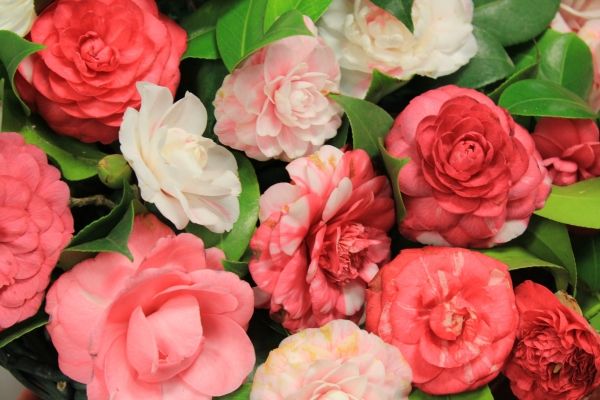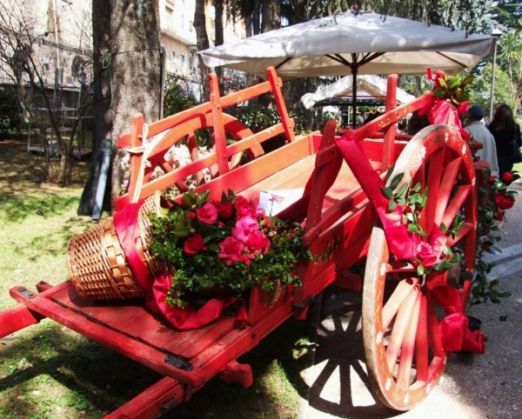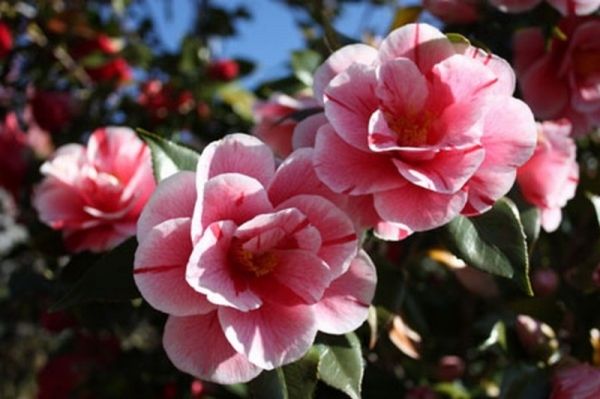What picture does Velletri conjure up in your mind? Someone well-versed in church history may know that 13 Velletri bishops subsequently became popes – quite a record for a small town bordering on the infamous Pontine marshes that once stretched halfway to Naples. Historians may also know that the emperor Augustus's family originated from ancient Velitrae, and if you are a gardening enthusiast you may just know that Velletri is the home of camellias. It is, in fact, the most important centre of camellia cultivation in Lazio.
The first camellia arrived in Velletri some 200 years ago and found its ideal habitat. It thrived in the rich volcanic soil of the Monte Artemisio foothills and from the 19th century onward no garden or vineyard in Velletri was without its beautiful pink, white and red blooms.
Eighteen years ago the town decided to honour its most distinguished flower with an annual festival in March, where growers could show off their rare hybrids and the public would have access to some of the most fascinating private camellia collections.
The festival is a unique occasion to admire camellias in all their glory. Most people are familiar with the basic variety that sprouts a myriad of deep pink, multi-petalled blooms during the early spring. However, there are innumerable variations.
Le Camelia del Generale nursery just outside Velletri has over 400 varieties ranging from creamy white to lemon yellow, palest blush to deepest crimson, candy-striped pinks and whites and dappled reds, with bloom heads ranging in size from a tea plate to a button, including a selection of the rarer scented camellias.
The nursery was created 30 years ago by Ettore Rolando, a retired artillery general. A passionate collector, he began the business as a hobby. It is now run by his grandson, Enrico Scianca, who says he became hooked on camellias after he graduated from university. The nursery is one of the most important producers of camellias, azaleas, rhododendrons, gardenias and other acidophilic plants in Italy, and exports to gardens all over Europe. The collection includes many rare camellias, including Scianca's pride and joy – a 26-year-old Baby Bear with minute pale pink flowers measuring only 2 cm across and valued at an estimated €7-8,000. “But I don't think I'll ever be able to bring myself to sell it,” he says.
The nursery contains a range of traditional 19th-century varieties, such as Incarnata (known as Lady Hume's Blush in English) and the white, spiral-petalled Vergine di Collebeato, along with the latest creations such as the magnificent Duchessa di Galliera, named after the Genoese philanthropist and presented at her centenary celebrations last spring, and the Camellia del Generale, named in honour of his grandfather, who died seven months ago at the venerable age of 100.
Cultivating camellias would seem to be good for you, judging by some of the other private collections we visited. Luigi Ceracchi is 98 years old. After ducking under a towering row of multi-coloured camellias we found him sitting in his wheelchair in front of the house where he was born, admiring the garden that he and his late wife Jolanda had planted together over the years.
Another delightful garden in Velletri belongs to Alberto and Amelia Castrichella, who have over 200 different plants spread over their estate on the slopes of Monte Artemisio, including a spectacular 90-year-old giant which had to have its head chopped off because its branches were poking into the house. Alberto's mother, Candida, started the collection many years ago and Alberto and his sister carried on her work, gradually ousting vines and other cultivations in favour of rare examples collected from all over the world.
It's easy to see why people become enamoured with camellias. Apart from the plant’s intrinsic beauty and stamina (it lives for hundreds of years and can survive temperatures of -15 degrees centigrade), it is one of the world's most romantic flowers. In western culture, it is linked to the image of the ill-starred Alexandre Dumas fils heroine, Marguerite Gautier, the Lady of the Camellias, resuscitated by Verdi as Violetta in La Traviata, but in the Orient, where the plant originated, the camellia is believed to have mystical powers.
The camellia arrived in Europe in 1739, brought from China by a Captain Goff of the British East India Company. He was actually interested in the infusion the Chinese brewed from the leaves of the sinensis variety of the plant; legend has it that the Chinese, who wanted to protect their product, cheated him by giving him the flowering sasanqua variety instead. It's a nice story, but botanists claim that the first flowering camellias, originally called “Tsubaki” – which means “rose” in Japanese – were brought to Europe around 1740 by a Jesuit priest, Father Georg Joseph Kamel, hence the shrub's European name.
The camellia arrived in Italy some 40 years later, when it was presented to Maria Carolina Queen of Naples, who planted it as a prized rarity in the gardens of the royal palace at Caserta. Soon after, it became a craze among all the aristocracy of Europe. Napoleon's wife Josephine allegedly spent a fortune on camellias for her garden at Malmaison. Looking at these lovely blooms, it's easy to understand why.
Margaret Stenhouse
The Velletri Camellia Festival is held every year on the third weekend in March. Le Camelie del Generale, Via Fienile 171, Velletri, tel. 0629069, 335/8368343.
The following gardens are not normally open to the public, but both owners welcome true garden lovers by prior arrangement. Luigi Ceracchi, tel. 069647217 Alberto Castrichella, tel. 069635266






















